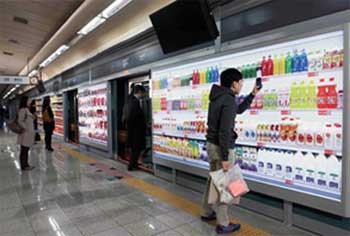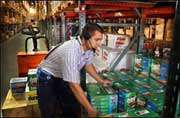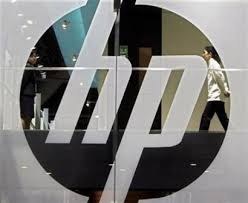 |
March 13, 2014 - Supply Chain Flagship Newsletter |
 |
| THIS WEEK'S SPONSOR: MHI |
 |
|
 |
|
|||||||||||||||||||||||||||||||||||||||||||||||||||||||||||||||||||||||||
A 360-Degree View of E-Fulfillment Part 2
|
||||||||||||||||||||||||||||||||||||||||||||||||||||||||||||||||||||||||||
| GILMORE SAYS: |
"By far the best articulation of the ideal approach to multi-channel inventory management across channels I've heard was from an LL Bean supply chain manager in 1999." WHAT DO YOU SAY? |
Quick numbers: Overall ecommerce sales in the US were up 16.8% in 2013. That compares to overall retail sales growth of 4.1% for the year (both numbers inclusive of inflation). Amazon itself grew its US merchandise sales 28% in 2013, down a bit from 34.4% in 2012, as the law of big numbers takes hold, but still incredible growth. That represented about $6.5 billion in absolute sales growth just in the US - those dollars obviously came directly out of some traditional retailers' hides. There are only so many mom and pops left.
But don't think for a second that ecommerce/multi-channel is just a retail thing. Obviously this impacts consumer goods manufacturers in the end. But what industrial products company isn't also impacted by e-commerce one way or another these days as well, in terms of its channels of distribution, order profiles, and more?
Amazon Supply, an e-channel for MRO items, is a growing force. Competitor Grainger recently noted how web ordering has changed its fulfillment requirements enormously, as business customers now place orders on-line after the first shift is over, in mid-afternoon, and Grainger promises those orders will be picked and shipped that same day. Not easy.
One last point from part 1: Given the ecommerce surge, we have far too much physical retail store space in the US, and as store counts and size shrink, it will impact the optimal supply chain networks of retailers and in some cases consumer goods companies dramatically.
Given all this, it's no wonder ecommerce/multi-channel is at the top of the priority list for about every retailer and many manufacturers. I recently spoke with a large regional grocery chain that said multi-channel was its number 1 priority - that's what Amazon getting into the grocery business will do to you.
Walmart's upscale Superama grocery chain now says about 20% of its orders come in on-line - and it delivers those orders from its stores in about three hours. Now, it is looking at dedicated "dark stores" for fulfillment.
In Tokyo, Tesco has virtual stores in downtown subway stations where workers can place orders via touch screen for what is usually that night's dinner materials, and the goods are there bagged and waiting when the consumer gets off at their station.
Tesco's Virtual Stores at Downtown Tokeo Subway Stations

So retailers and manufacturers are spending money - there is a reason why Manhattan Associates' stock has been hitting record highs. That is including spend for both front end (consumer facing) and back end (fulfillment systems) capabilities. The odd thing about multi-channel commerce and fulfillment is that about as much as anything I have seen in supply chain, it is almost completely a technology deal. Your systems support order on-line and pick up in store or they don't. You can support drop shipping from some or all suppliers or you can't.
You can have all the process excellence there is, but if the systems won't support the strategies you want to employ, a retailer or manufacturer generally has to just wait until those capabilities are built or bought. In most supply chain areas, there are manual workarounds - not here.
Think of the complexity. A couple of years ago, a Macy's executive said the retailer had identified what I believe were 16 different combinations of order point and fulfillment paths that it was working to support. That means it was defining processes and building system capabilities for all of those 16 order-fulfillment pairs. I don't know this was one, but for example: order in-store, vendor drop ship. Macy's said there were actually a handful of additional combinations, but it thought these others would be rare enough they would plan to handle manually.
And all for little or no profit now. I have it on good authority that one of the US' most recognizable retailers is losing 15% of sales on its ecommerce unit. For most traditional retailers, ecommerce is a tiny percent of revenues, and very hard to get into the black.
Last year, for example, Target responded to an SEC question that "digital sales represented an immaterial amount of total sales," despite recent double digit growth levels.
Walmart's global ecommerce sales reach $10 billion last year, the company said. That represented just about 2% of total sales, however, though again rising very rapidly versus slow growth brick and mortar numbers.
For all its sales growth and big numbers, Amazon generally loses or makes a few million either way each quarter. Massive investment in fulfillment centers and IT systems is the key factor in that lack of profitability.
As we commented here a few weeks ago, Amazon's fulfillment costs as a percent of merchandize sales are huge, as shown in the graphic below. We'll also note that while these fulfillment costs include inbound logistics costs to get goods to fulfillment centers, they do not include outbound customer shipping costs.
As can be seen in this chart, measured that way, fulfillment costs at Amazon rose to 17.5% of merchandise sales in 2013, up from 15.7% in 2010.
And I haven't even gotten to inventory management. We mostly all understand now that totally separate inventories by channel isn't a good thing - but there are also issues with virtually every alternative to that approach as well.
By far the best articulation of the ideal approach to multi-channel inventory management across channels I've heard was from an LL Bean supply chain manager in 1999. His vision worked like this:
Forecasts by channels would be consolidated and then a single safety stock factor applied. Then, as sales occurred over some period (e.g. a month), each channel's inventory position relative to the forecast is debited. If a channel in a period exceeds its forecast allocation, it can take inventory from other channels (never lose a sale) at no charge if channel is behind forecast, but with crosscharge paid to other channel(s) if the other channels are at forecast sales levels.
Anyone have system that yet? It is actually something of a combination of available-to-promise capabilities combined with service policy optimization logic. It makes perfect sense, but if anyone has taken it this far, I haven't heard of it.
Once again, I am out of space. Here, I believe, are the seven key efulfillment issues that companies must formally wrestle with:
Order Profiles: How is multi-channel commerce impact the composition and timing of customer orders?
Defining the Omni-Channel Experience: Just how much do we really want same experience and prices through all channels? Does that really make sense?
Order Management: How will order management be handled across channels? Includes the potential role of so-called Distributed Order Management (DOM) systems.
Managing Fulfillment Costs: You must take out every penny, and understand inter-relationships, such as packing policies and return volumes.
Inventory Management Policies: As discussed above
Fulfillment Center Strategy and Design: What is done where, insource vs outsource, capabilities required.
The Role of Stores in eFulfillment: Huge ramifications in terms of system requirements, inventory accuracy and more.
I have plenty enough for a part 3 - may just do that before long. I didn't even get to drones.
Any reaction to this part 2 piece on efullfillment? Let us know your thoughts at the Feedback section below.
| View Web/Printable Version of this Page |
|
|
|
YOUR FEEDBACK
Related the above, few weeks ago we published a column presenting some of the operating and financial numbers of the two biggest forces in retail, Walmart and Amazon.
We received a few emails in response, including our Feedback of the week from Francois Charvet, with some smart questions as he interacts with SCDigest editor Dan Gilmore on Amazon fulfillment costs.
Feedback of the Week: On Amazon Fulfillment Costs:
As usual, very interesting piece, Dan. Two thoughts crossed my mind regarding the 17.5% fulfillment as percentage of sales: Francois Charvet, Ph.D., CSCP, CAP Dan Gilmore's response:
Media sales were about $10 billion in 2013. General merchandise was about $47 billion. Amazon does not split out electronic vs physical. Let's say it was 70% physical books, 30% ebooks, music, etc.
Adding that in would certainly know the percentage of fulfillment down but, not significantly. Would still be in double digits. Big driver is depreciation costs on new DCs. Trying to separate that out would be interesting.
Also confusing is how Amazon accounts for sales of products fulfilled by the sellers, which is a large amount, based on my own personal experience. I know some of the Wall Street analysts who follow AMZN – let me dig on all these areas. The AMZN numbers give you a lot of info, but always leave a piece out that is needed to get the complete story. (Still working on it). |
||
| More on Amazon and Walmart Numbers | ||
Good look at where we have been. Amazon is laying the foundation for the "Grocery" explosion. Walmart is focusing on growing both online grocery and general merchandise.
James A. Tompkins, Ph.D. |
||
Outstanding data summary on Walmart and Amazon.
Thank you for putting this together. Very insightful. Keep up the great work.
Roger Jones St. Louis |
||
SUPPLY CHAIN TRIVIA ANSWER
Q: What share of global demand for soybeans does China represent?
A: An astounding 66% in 2013, the same share as for iron ore. China also consumed 44% of global copper output, but just 11% of oil.
| © SupplyChainDigest™ 2003-2013. All Rights Reserved. SupplyChainDigest PO Box 714 Springboro, Ohio 45066 |
POWERED BY: XDIMENSION
|








